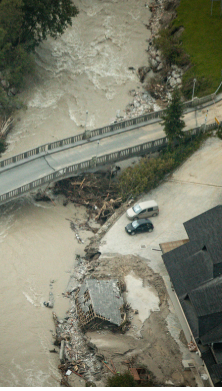1. Introduction
Water quality and availability are among the decade’s top emerging risks. By 2050, the world’s population is expected to reach 9.7 billion. It will be 11 billion by 2100. All these people will need water to meet their most basic needs. Agriculture, industry and domestic life rely on the abundant supply of safe water.
Water risks represent major emerging risks for water-intensive businesses, the re/insurance industry and for global society in terms of scarcity, pollution, health, treatment, conflicts, regulatory and reputational risks. Yet they are often underestimated, disregarded or simply ignored.
Water risks are complex to assess. Such difficulty stems from the paradoxical nature of water: it is plentiful to many, yet its scarcity affects hundreds of millions of people, it is both fossil and renewable, it is freely supplied by nature but its treatment, distribution and wastage have a cost.
The majority of water risks represent externalities which are not yet properly priced or assessed by most businesses. This results in a global lack of preparation.
This AGCS ESG Risk Briefing summarizes selected key findings of the position paper published by the Chief Risk Officers Forum on water risks in November 2016.


2. Water scarcity

3. Pollution of water
Water pollution, i.e. the contamination of water bodies with chemicals or other foreign substances, is a growing issue. Contamination stems from industry, agriculture and urbanization. The main industrial activities accountable for major water pollutions are mining/ quarrying activities, manufacturing industries, production/ distribution of electricity and construction. Oil contamination often occurs from extraction operations, fuel stations and refineries. Non-remediated industrial sites, underground storage or waste disposal can discharge highly toxic pollutants into the environment.
In modern agriculture, factory farming and intensive cultivation of fields contribute to pollution of the ground and land surfaces through soil erosion, fertilizers, pesticides and animal waste.


Groundwater in cities is usually unsuitable for drinking or bathing because of contamination. Multiple contaminants migrate to the ground water though rainwater infiltration, leaking sewage, hospital effluent, landfill leachates, fertilizers used in gardens and parks amongst others. Also, insufficiently treated waste water discharges into rivers and can cause environmental degradation of the water downstream.
In China, for example, more than 80% of the groundwater is contaminated and necessitates legal restrictions on use.


4. Dependency of water
Low water quality continues to be a major source of global morbidity and mortality. Each year 2.6 million people die in the world due to the consumption of polluted water as a result of a lack of or inappropriate sanitation. Water is one the most critical resources for humanity.
Water risks, especially scarcity and pollution pose not only a direct threat to the local population and environment but also to the operation of water-intensive industries. Especially in regions where water is not abundant, conflicts over the use for industrial operations and water for the local population arise. The identification and management of water risks is key for water intensive industries. Good water management helps to limit conflicts with local populations, non-governmental organizations and governments. Such conflicts can lead to business interruptions and/or the loss of operating licenses.
As water is a highly emotional natural resource, reputational exposures can escalate to loss of customers and market share.


5. Water treatment
Treatment of water and waste water is both a priority and a challenge. Lack of treatment is an issue in many emerging countries, as it is costly and energy intensive. Consequently, the availability of water treatment is often correlated with economic prosperity.
The need for water treatment is growing, new technologies are being developed, e.g. desalination is an emerging process increasingly used. However, this method is more energy intensive than traditional methods. Because of its high costs, it is also only adapted for dry regions. Large projects are developing in the Middle East, U.S. Australia and Europe. The El Prat desalination plant in Spain is Europe’s largest desalination plant and supplies 24% of the water consumed in the Barcelona metropolitan area. 200 million liters of drinking water are supplied daily to the region’s 4.5 million inhabitants.


6. Role of the Re/Insurance industry
Infrastructures such as desalination plants require tailored insurance programs to address their specific needs. Challenges come from their generally large size, use of advanced and costly technologies (some time being prototypes), usual proximity to large population centers and vulnerability to natural catastrophes.
Finding of the Allianz Risk Barometer 2017: Business interruption continues to lead risk rankings as new non-physical damage triggers emerge. Water-related business interruptions are usually not covered by traditional re/insurance solutions, however, losses can be significant.
The role of AGCS
AGCS advices water intensive businesses to identify and assess the dependency on local water supply and potential water shortage scenarios as part of their business continuity planning for existing and new facilities. Not only obvious water risks such as scarcity and pollution are important to consider but also fire, cyber-attacks, political violence or even terrorism targeting water suppliers are potential risks to consider.
AGCS can support with our Risk Engineering and insurance solutions in mitigating the financial impact or develop tailor made solutions for Risk Funding.
RESOURCES AND LINKS
WATER RISKS, CRO FORUM, NOVEMBER 2016
AGCS RISK BAROMETER 2017















